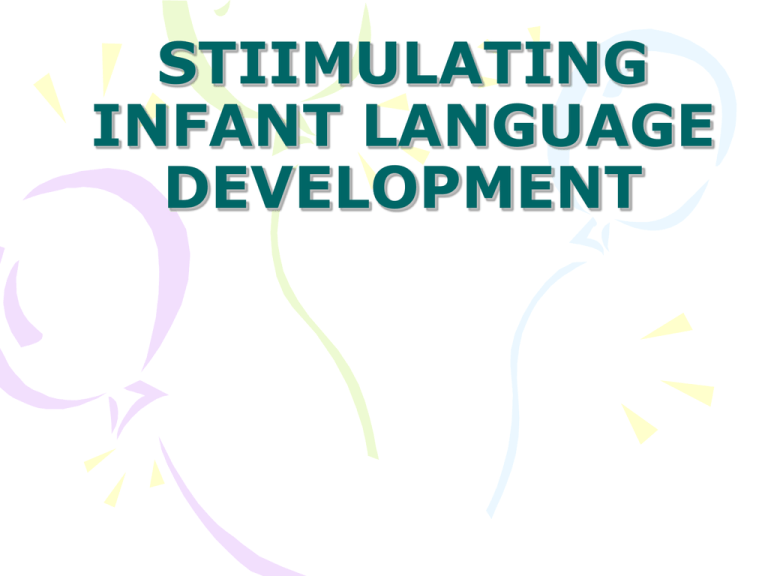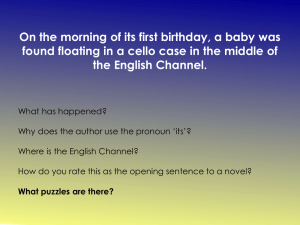Infant Language Stimulation
advertisement

STIIMULATING INFANT LANGUAGE DEVELOPMENT I. INTRODUCTION AND BACKGROUND** Research: human brains begin development very early Early months and years of life are critical and can be predictive of eventual lifetime achievement Youtube… • 3 month old baby clearly says I love you • Amazing! Sheehan (Stanford Child Neurology); child’s brain is: The research of Fowler and colleagues:** 2 groups of babies Group A: began language stimulation at 4 months Group B: began language stimulation at 12 months Justice, L. & Redle (2014). Communication sciences and disorders: A clinical evidencebased approach (3rd ed.) Turnbull & Justice 2012 summarize research of key indicators of caregiver responsiveness: Research of Tamis-LeMonda and colleagues: One study showed that: The most powerful mechanism… Youtube • Still face experiment • Shows how important caregiver responsiveness is! II. GENERAL LANGUAGE STIMULATION IDEAS Cheap, easy--daily life! 1. Start talking to the baby at birth** Face to face contact is ideal 2. Begin reading to the baby very early When reading to the baby,** Use simple books with colorful pictures Label common objects and actions for the baby (“Look— bear. The bear is eating.”) Youtube • Early Literacy: Sharing Language One of my personal favorites: My children’s book program… • Emphasizes Love, Talk, Read Not this!! 3. Introduce music** Sing to the baby Play music The baby can play! 4. Ask questions 5. Introduce 2 languages from birth 6. Introduce the baby 7. Play turntaking games** Peek-a-boo Patty cake 8. Remember that most newborns 9. Put a safe-glass mirror** In the baby’s crib Point out and label her body parts 10. Imitate sounds the baby makes 11. Use greetings and expressions 12. When cleaning the house or going on errands… 13. Provide many opportunities 14. Make sure Even paper can work! • Youtube • Baby laughing at ripping paper • Micah is 8 months old Youtube Hysterical over bubbles What are some common house hold items that the baby can play with? What are some cheap/free activities to do? 15. Let the baby 16. Label 17. Use the same words 18. Start a scrapbook** Soft cotton cloth book Cut favorite animals and favorite objects out of fuzzy cloth; glue them into the book Go through the scrapbook with the baby; have him feel the pictures as you name them You can also let the baby touch other pictures and objects III. LABELING PLAY: THE RESEARCH OF WILLIAM FOWLER** Labeling play: naming common objects that babies encounter in their daily experiences There are ways to specifically do this that make words easier to learn The keys: For example:** There’s the cat. Here’s your bottle! I see Grandpa. Advantages of Word Labeling over Ordinary Speech: Ordinary speech: proceeds in the background, unrelated to baby’s attention or interest Word labeling: engages baby’s attention directly There’s the doggy! See the doggy? Word labeling: Ordinary conversation: Word labeling: Ordinary conversation: The bottom line is….. variety!





